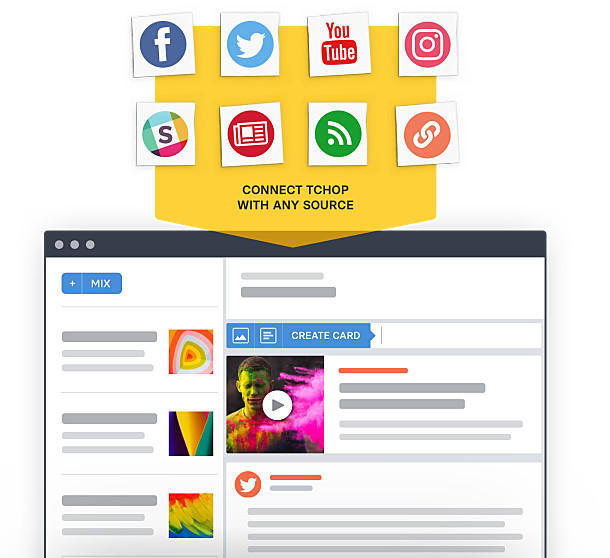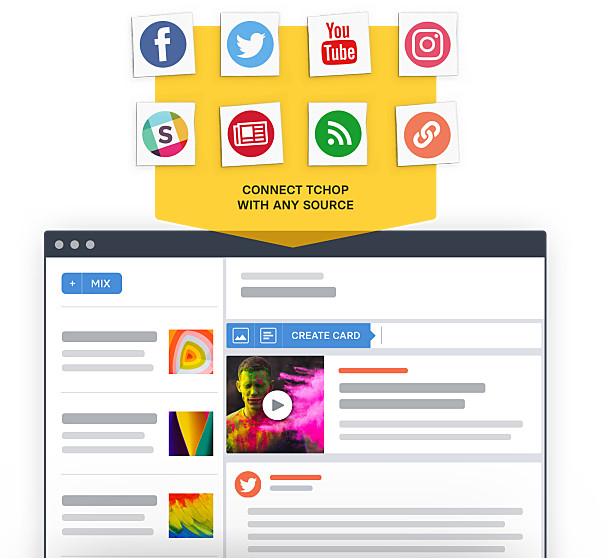
Today there is almost no media company, no blogger and no communication department that does not use different newsletters every day and publishes them regularly themselves. Email newsletters are a simple and efficient way to communicate content directly and are very popular. So we thought: why don’t we build an integration to import any content from any email newsletter?!
After all, there is a lot of exciting, sometimes exclusive, content distributed in newsletters today. This is often lost in the general confusion of your own email inbox. Also the user experience is also not always great within the well-known email apps.
In our own tchop channel, on the other hand, you can structure, store and distribute the content as you want. You can comment, edit or remix it with a few clicks since we convert the pieces into real native content types (text, images, links etc). Plus: Within your own branded app you and your users benefit from a premium mobile experience, that is optimized for the device with latest native app technology (email newsletters are simple HTML).
You can also combine newsletter content with other content and functions or create a community around it. Just think of comments and likes here.
How does the newsletter integration work?
Practically all newsletters are based on a fixed content structure, which technically means on a kind of html template. Almost in all cases, a special tool such as Mail Chimp is used for sending the newsletter (we use this tool for our own newsletter as well). Corresponding templates are created in those tools, which provides a consistent structure of almost all newsletters – regardless of whether it is sent daily, weekly or monthly.
And this is exactly where we start! Based on custom processing routine, which is created once for each newsletter format, we are able to transfer texts, images or links from the newsletter into content cards in any selected mix or section. We can create one long text card or deconstruct the whole thing into individual cards. You can display links in the text or parse them as a teaser. That means you can adapt the integration to the individual requirements and the specific newsletter.
We create this processing routine together for our customers. It never works fully automated as every newsletter has a different structure. However, if the routine is set once, all subsequent newsletters are automatically transferred to the predefined structure. Therefore two things need to be discussed in advance:
- which newsletter(s) should be imported and
- how exactly it should be parsed in terms of content structure and
- where it should be integrated
Of course, all content in tchop can then be further processed, edited, commented on or completely restructured. As usual, you can also choose whether all newsletters should be included in one mix. Or whether a new mix should be created automatically for each newsletter. You have full control over the output at any given time.
What can this integration be used for?
The use cases are quite diverse. Of course you can simply use the whole thing to import your own newsletter content. You save your own team double work or the need to manual import or to develop an import from your newsletter tool. Once set up, the integration works fully automatically. If a new newsletter has been sent, the corresponding content automatically appears in the desired structure in your own app. Nobody has to do one click.
Of course, you don’t have to limit yourself to your own newsletters. You can easily curate exciting newsletters on any topic or from any sender and bundle them in your own content stack to keep employees, colleagues or members up to date. Since there is more and more exclusive newsletter content distributed via email, such an aggregation provides huge as you can reach out to the users that matter. You don´t have to force anybody to add another email to its inbox. Plus you can structure, sort and comment within the community right away.
In both cases you have the choice: the parsed newsletter content can be published automatically – then there is no additional effort needed. Or you can import the content first in order to then manage and adjust it in a second step in your editorial dashboard. In this case, you can import newsletters for your own editorial research and then filter what is really relevant for your target group. Since the content is already in the correct card based format, this can be done with just a few clicks and drag & drop.
If you are interested in a newsletter integration, just contact us. Tell us the newsletters you want to import and we can set it up for you within a few hours.
You will be amazed! 💪🏼









